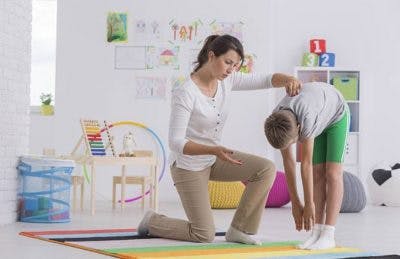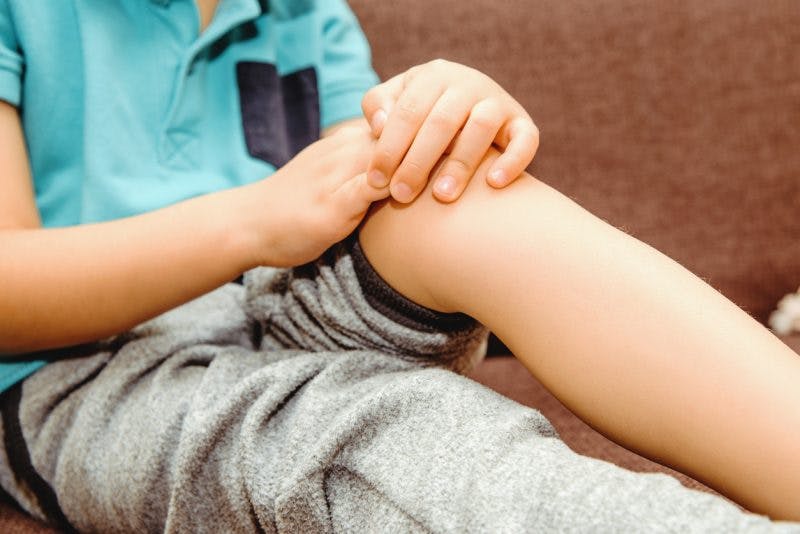Knee pain due to cerebral palsy is a fairly common secondary effect. In fact, nearly 21% of individuals with cerebral palsy that can walk experience knee pain. Without proper management, knee pain can be extremely uncomfortable and significantly affect one’s mobility.
This article will teach you how cerebral palsy can cause knee pain and what you can do to manage it.
Does Cerebral Palsy Cause Knee Pain?
Knee pain in individuals with cerebral palsy is most often caused by spasticity in the muscles around the knees including the hamstrings (the muscles at the back of the thighs), quadriceps (the muscles at the front of the thighs), and calves.
Spasticity describes involuntary muscle contractions, which can place a lot of strain on the knees and limit range of motion. Movements are performed through the relaxing and contracting of muscles. With spasticity, the muscles cannot relax, and movements become stiff.
Walking with the knees continuously bent, as may occur with spasticity, places a lot of pressure on the patellofemoral joint (where the kneecap rests on the thigh bone), which will ultimately result in knee pain.
Feeding problems caused by difficulties controlling the oral muscles necessary to chew and swallow are a common associative condition of cerebral palsy. This can lead to malnutrition, which, along with physical inactivity and a lack of bearing weight through the legs, can contribute to osteoporosis (decreased bone density).
Weak bones will make it difficult for individuals to support their weight, and when paired with spasticity, can result in pain and the inability to walk.
Additionally, physical inactivity can also lead to obesity. When your body is too heavy, your joints suffer and there are greater chances of developing knee pain.
How to Manage Cerebral Palsy-Related Knee Pain
Early management of cerebral palsy knee pain is essential for improving quality of life. Unmanaged knee pain can progress into adulthood and typically worsens with age.
Severe cases of knee pain can even result in an inability to walk. If this persists and walking is ceased, the muscles involved in walking will weaken, making it more difficult to return to walking in the future.
These five treatments will help prevent or relieve your knee pain.
1) Regular Stretching

Regular stretching will help expand range of motion and lengthen tight muscles. The more you stretch, the less severe your contractions will be, and the less strain there will be on your knees. Be careful not to overstretch. Stop if you feel your pain increasing.
2) Physical Therapy
Physical therapy will help ensure that individuals with cerebral palsy are exercising their spastic muscles. Increased movement will help reduce the excitability of spastic muscles.
Gait training is a type of physical therapy that focuses explicitly on improving walking patterns and abilities. Learning to walk with correct form will help ensure that weight is evenly distributed when you try to walk, which will reduce the burden on the knees.
3) Pain Medications
Pain medications can help reduce knee pain but will also affect the entire body when taken orally. Botox injections may be a better alternative to manage spasticity and reduce knee pain.
By injecting the nerve blocker directly into the spastic muscle, only that muscle will be targeted and affected. Botox injections help expand mobility and have antinociceptive (pain-blocking) effects.
It’s important to understand that medications will only temporarily relieve pain and do not solve the underlying problem. Therefore, it’s ideal to take advantage of the increased mobility and stretch spastic muscles, practice walking with correct form, and strengthen weak muscles for more long-term relief.
Read more about using Botox to manage cerebral palsy »
4) Braces

Braces will help combat spasticity by gently stretching contracted muscles and promoting proper alignment of the legs. They can also help stabilize the knees and prevent them from dislocating due to uneven muscle pull.
5) Surgery
Surgery should only be considered when all other treatments fail. Growth continuously affects the way children walk, so surgical intervention should be deferred as long as possible.
A selective dorsal rhizotomy is a type of surgery that involves making small incisions at nerve segments to denervate spastic muscles. Manual muscle lengthening surgeries are also commonly performed.
Avoid Falling into the Negative Feedback Loop
Children with cerebral palsy need to be as mobile as possible to prevent muscle atrophy (muscle wasting), learned non-use, and joint problems.
The less active your child is, the stiffer their muscles will become, and the more difficult it will be for them to move. Through this negative feedback loop, children with cerebral palsy can gradually lose the ability to walk.
Knee pain caused by spasticity is often not problematic until children get older, but that does not mean you should wait until it gets bad before intervening.
Early management is key for preventing knee pain and optimizing long-term mobility. Hopefully, this article helped you better understand the causes of cerebral palsy knee pain, and how to manage it.











